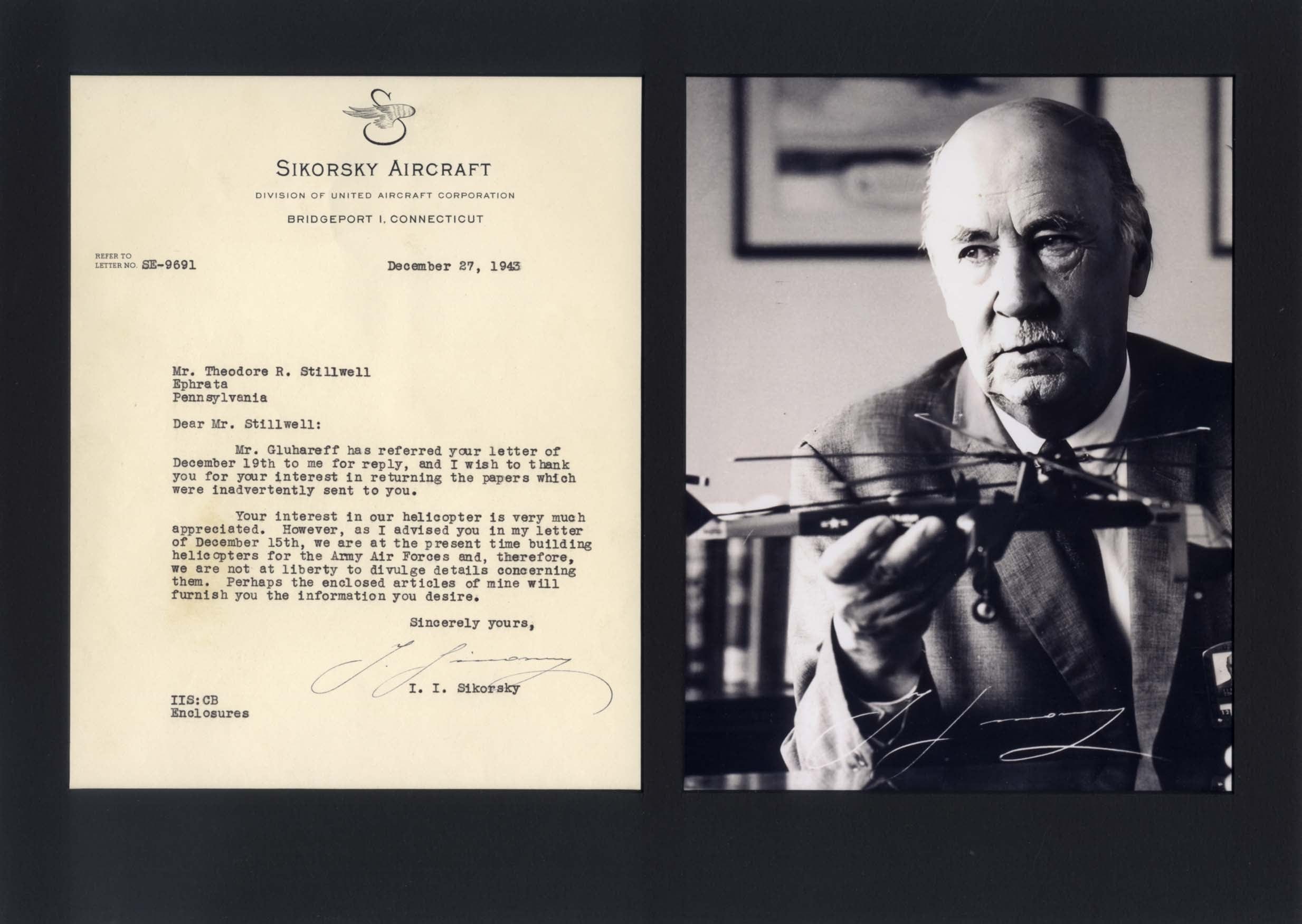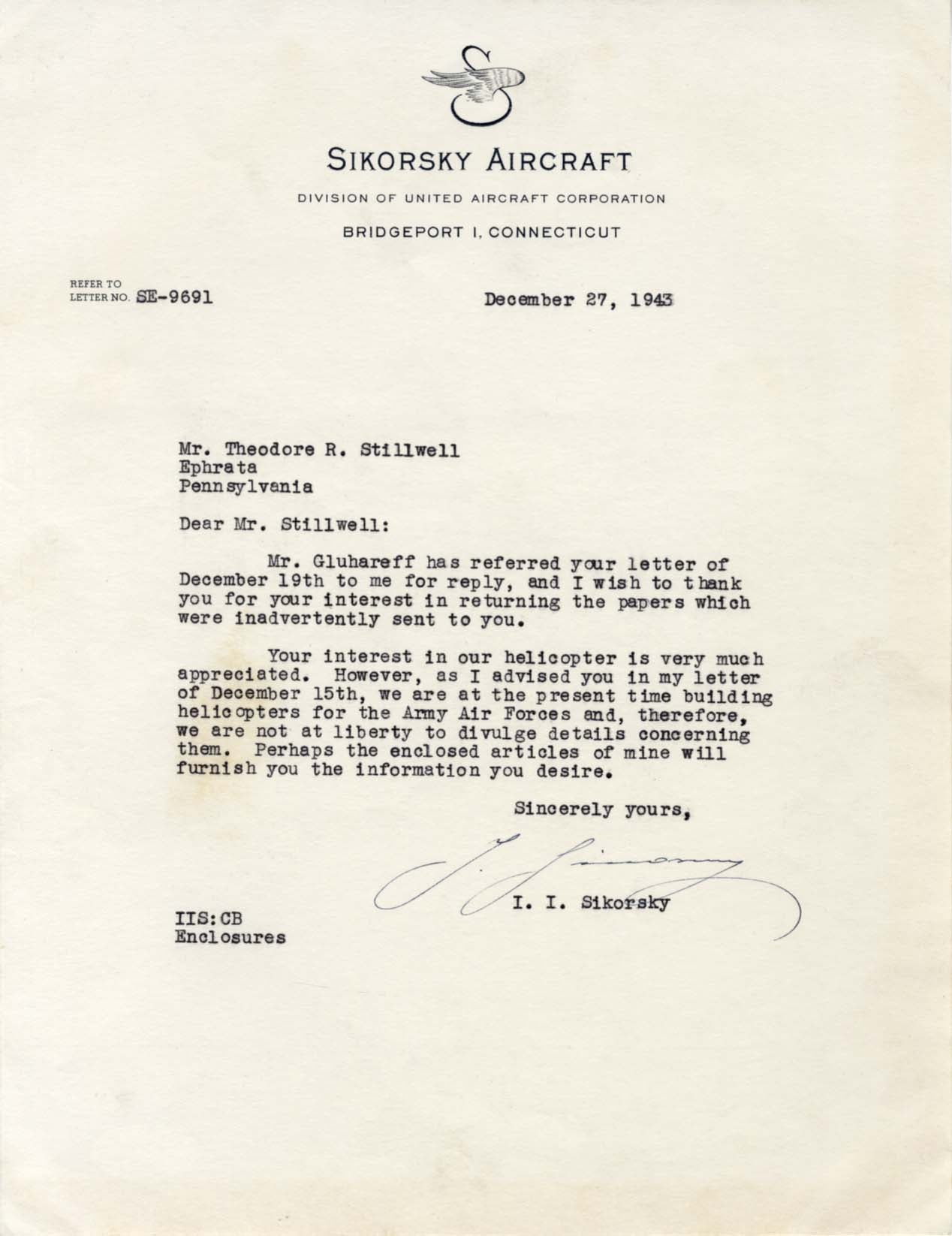Descripción
In parts:
"[...] thank you for your interest in returning the papers that were inadvertently directed to you. Your interest in our helicopter is very much appreciated. However, as I advised you in my letter of December 15th, we are at the present time building helicopters for the Army Air Force and, therefore, are not at liberty to divulge details concerning them [...]"
Más información sobre la persona
Profession:
(1889-1972) Russian American aviation pioneer in both helicopters & fixed-wing aircraft
Year of Birth: 1889
Igor Sikorsky was an aviation pioneer who is best known for designing the first successful helicopter. He was born on May 25, 1889, in Kiev, Russian Empire, and was the youngest of five children. His parents, Ivan and Mariya Sikorsky, were educated and cultured people, and Igor was exposed to a variety of interests at an early age. He was particularly interested in aviation, and in 1910, at the age of 21, he designed and built his first aircraft. The plane flew briefly, but it was a major breakthrough in the development of heavier-than-air craft.
Sikorsky continued to pursue his passion for aviation and in 1914, he established the Russo-Baltic Carriage Factory, a company that produced airplanes. He also designed the world's first four-engine aircraft, the Russky Vityaz, which was used during World War I. In 1919, Sikorsky moved to the United States, where he established the Sikorsky Aero Engineering Corporation. He continued to develop aircraft for commercial and military use, including the S-38 amphibious aircraft, the R-4 helicopter, and the S-51 helicopter.
In 1942, Sikorsky achieved his greatest success when he designed and flew the VS-300, the world's first successful helicopter. The VS-300 set the standard for modern helicopter design and was used for a variety of purposes, including search and rescue, medical evacuation, and transportation. Sikorsky's other achievements include the development of the first successful intercontinental passenger jet, the S-52, and the first mass-produced helicopter, the S-55. He also developed the first commercial helicopter, the S-58, which was used for air taxi and air ambulance services.
In addition to his work in aviation, Sikorsky also contributed to the development of the nuclear submarine. He designed and built the Nautilus, the world's first nuclear-powered submarine, which was launched in 1955. He also invented the "Sikorsky Amphibian," an amphibious vehicle that was used for both land and sea travel. Throughout his career, Sikorsky received numerous awards and honors, including the Collier Trophy, the Wright Brothers Memorial Trophy, and the Goddard Award.
Igor Sikorsky died on October 26, 1972, in Easton, Connecticut, at the age of 83. He is remembered for his innovative contributions to the field of aviation and his impact on modern aviation technology. He is also remembered as a humanitarian who was dedicated to helping his fellow man. To this day, the Sikorsky name is synonymous with excellence in aviation and is a symbol of progress and innovation.
Igor Sikorsky's legacy will continue to live on for many generations to come. His pioneering spirit and tireless dedication to his craft have inspired countless people to pursue their own dreams and continue to push the boundaries of aviation technology. He will always be remembered as a true aviation pioneer and an incredible innovator.
Certificado de autenticidad
Todas nuestras piezas se venden con un certificado de autenticidad. Si una pieza resulta estar equivocada o si no le gusta un autógrafo, recuperará su dinero durante toda la vida.
Pago y seguridad
Su información de pago se procesa de forma segura. No almacenamos los detalles de la tarjeta de crédito ni tenemos acceso a la información de su tarjeta de crédito.


